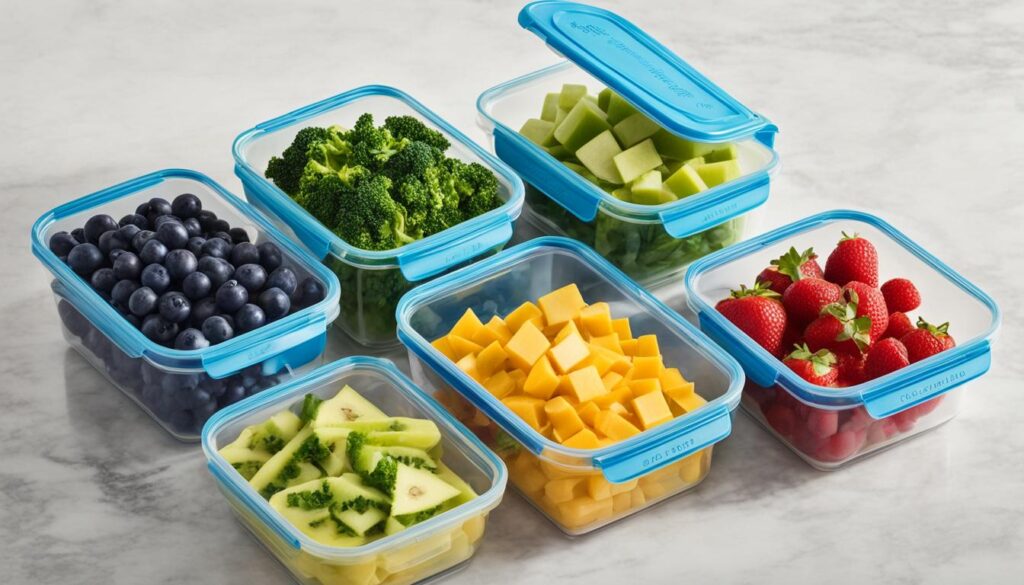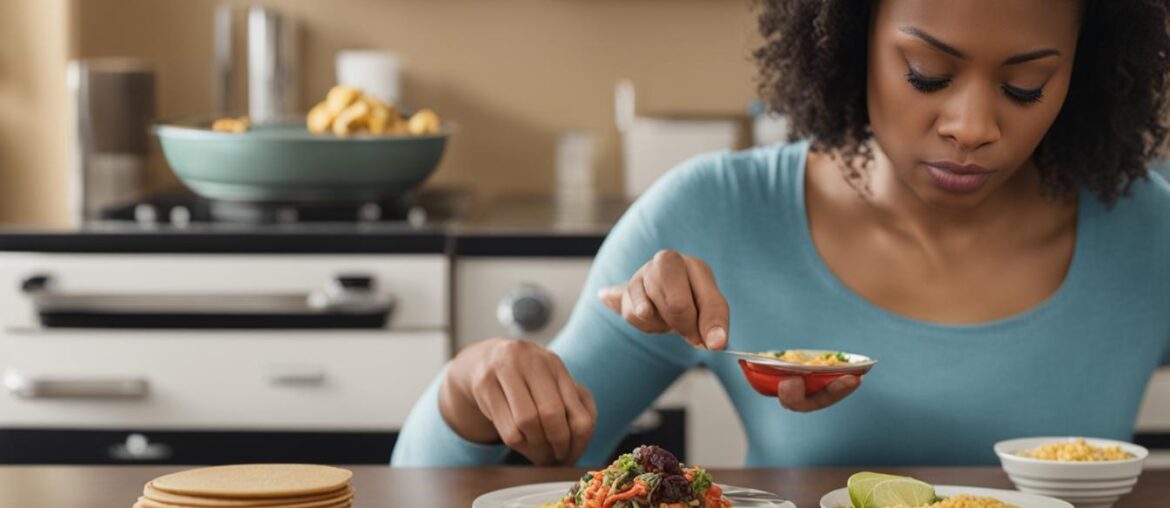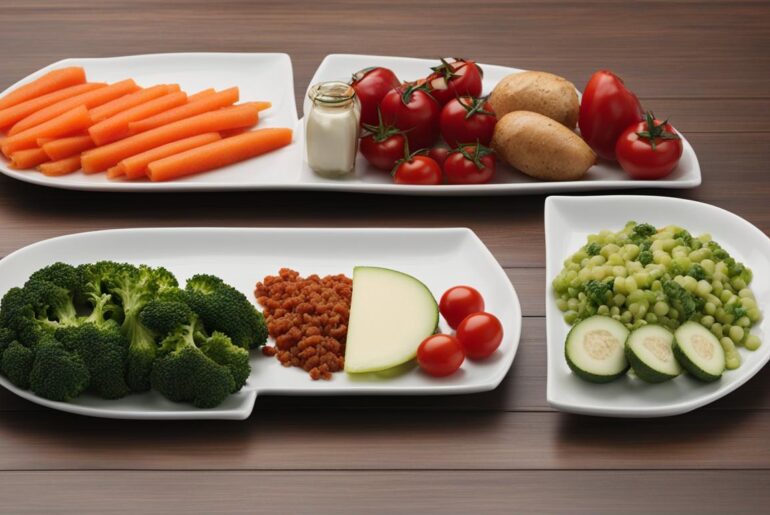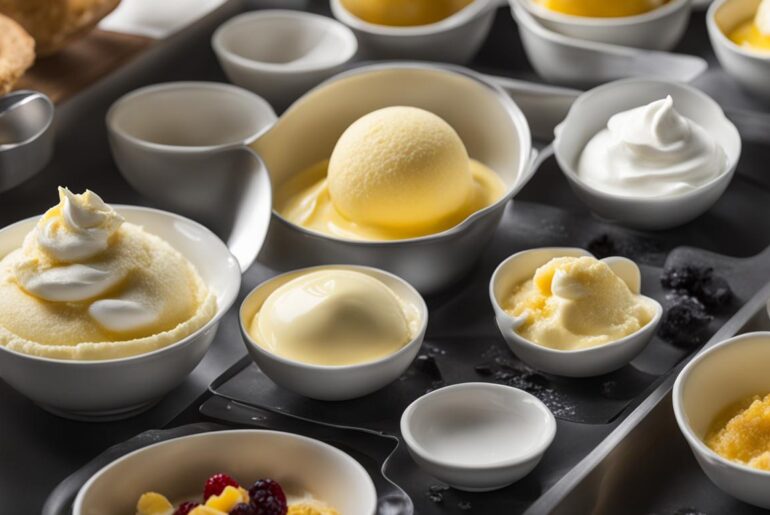Are you struggling with portion control? Do you find yourself mindlessly eating and unable to regain control over your portion sizes? You’re not alone. Many people make more than 200 unconscious decisions about food each day, leading to overeating and weight gain. But fear not, because I’m here to share with you 13 science-backed tips to help you stop mindless eating and conquer your portion control struggles.
Key Takeaways:
- Using visual reminders of the food you consume can make you more mindful of your eating habits.
- Favoring smaller packages can help reduce the number of calories you consume without even realizing it.
- Using smaller plates and taller glasses can trick your mind into perceiving larger portions.
- Reducing the variety in your meals can prevent overeating and promote portion control.
- Listen to your body’s internal cues and eat according to your hunger and fullness signals.
Using Visual Reminders
Behavioral scientists have discovered that our food choices are often influenced by external cues rather than internal hunger and fullness signals. By using visual reminders of the foods and drinks we consume, we can cultivate a greater sense of mindfulness and awareness regarding our eating habits. Studies have shown that individuals who had visible evidence of what they had eaten, such as chicken bones or empty beer bottles, tended to consume less compared to those whose tables were cleaned.
Keeping visual reminders can play a crucial role in promoting mindful eating, preventing overeating, and ultimately assisting in portion control. By having a visual representation of the foods we have already consumed, we are more likely to be conscious of our intake and make conscious choices about further consumption.
“Using visual reminders of the foods we consume can aid in cultivating a greater sense of mindfulness and awareness of our eating habits.”
Visual reminders serve as a tangible cue that prompts us to pause, reflect, and consider our hunger and fullness levels before consuming more. This mindful approach to eating allows us to break free from the cycle of mindless overeating and make more conscious decisions about portion sizes.
The Power of Visual Reminders
Visual reminders hold significant potential in influencing our eating behaviors. They serve as a tangible link between our food choices and our level of satisfaction, ensuring that we remain more conscious of our overall consumption. Whether it’s leaving food packaging on the table or displaying empty plates, visual cues can help create a physical representation of our eating experiences, preventing mindless overeating.
By incorporating visual reminders into our daily routines, we can combat the habits of mindless eating and develop healthier portion control habits that promote overall well-being (see my post here). It’s essential to be mindful of our food choices and be conscious of the cues that influence our eating behaviors. Remember, every small step towards awareness can make a significant difference in fostering a healthier relationship with food.
| Visual Reminders | Impact |
|---|---|
| Leaving empty food containers on the table | Helps create awareness of portion sizes and prevents overeating |
| Displaying plates or bowls after a meal | Serves as a reminder of consumed food, preventing mindless snacking or overindulgence |
| Keeping a journal or diary of meals | Allows for reflection on food choices and encourages mindfulness |
Favoring Smaller Packages

The size of our food packaging can have a significant impact on our eating habits. Research has found that the portion size effect explains how larger packages can lead to overeating. However, by favoring smaller packages, we can reduce our calorie intake without even realizing it.
| Study | Findings |
|---|---|
| Research on potato chips | People who ate chips from cans with dyed chips consumed fewer chips compared to those eating from cans without dyed chips. |
| Study on M&Ms | Individuals who consumed M&Ms from a large bag ended up consuming more calories than those who were given smaller portions. |
Choosing smaller packages can effectively help us control portion sizes and prevent mindless overeating. By offering visual cues and limiting the amount of food available, smaller packages support portion control habits. Whether it’s resealable portion control containers for snacks or downsizing our grocery purchases, opting for smaller packages can be a powerful tool in managing our food consumption.
The Science Behind Smaller Packages
Research shows that the perception of portion size plays a crucial role in determining how much we eat. Larger packages create a visual illusion that the content is a smaller portion, leading us to serve ourselves more. On the other hand, smaller packages can make the same amount of food look more substantial, helping us eat less.
“Favoring smaller packages can help control portion sizes and prevent mindless overeating.”
Additionally, smaller packages provide built-in portion control. Instead of mindlessly reaching into a large bag of snacks, having pre-portioned packages can help us better manage our calorie intake. By consciously choosing smaller packages, we can develop healthier eating habits and maintain better control over our portion sizes.
Using Smaller Plates and Taller Glasses
The size of our plates and glasses can significantly impact how much we eat. Studies have revealed that utilizing smaller plates can help reduce portion sizes by up to 27%. This happens because larger plates make our food portions appear smaller, leading us to serve ourselves more food than necessary. By using smaller plates, we can adjust our perception of portion sizes and promote more mindful eating habits.
Similarly, the shape and size of our glasses can also influence our liquid intake. Research suggests that using taller glasses instead of wider, shorter ones can reduce liquid consumption by up to 57%. The visual cues provided by taller glasses can create an illusion of increased volume, making us perceive that we are consuming more liquid than we actually are. This simple switch can help control portion sizes when it comes to beverages.
| Using Smaller Plates | Using Taller Glasses |
|---|---|
| Reduces portion sizes | Limits liquid intake |
| Tricks the mind into thinking we are eating more | Creates an illusion of increased volume |
| Promotes mindful eating habits | Helps control liquid portion sizes |
By replacing large plates with smaller ones and wide, short glasses with tall, thin ones, we can take advantage of these visual cues to control portion sizes and prevent mindless eating. These simple adjustments can have a significant impact on our overall food consumption, helping us achieve our portion control goals.
Choose Smaller Plates, Control Your Portions
“Using smaller plates not only tricks the mind into thinking we are eating more, but it also promotes a more mindful approach to our food choices. By consciously selecting smaller plates, we take control of our portions and create a healthier relationship with food.” – Dr. Samantha Roberts, Nutritionist
Decreasing Variety in Meals
Research has revealed that having a wider range of food options can contribute to overeating. This concept, known as sensory-specific satiety, indicates that our senses can become desensitized when exposed to the same flavors repeatedly. To prevent overeating, it is advised to limit our food choices and reduce food variety.
Studies have demonstrated that participants who were presented with bowls containing a greater number of colors of M&Ms consumed more candies compared to those presented with bowls containing fewer colors, even though all the candies tasted the same. This suggests that the variety of flavors, colors, and textures that we encounter can influence our portion control habits.
By deliberately reducing the variety of flavors, colors, and textures in our meals, we can help prevent overeating and promote better portion control. This can be achieved by consciously selecting a limited number of food options and incorporating more monotony into our diet. By doing so, we can overcome the sensory-specific satiety effect and regain control over our eating patterns.




